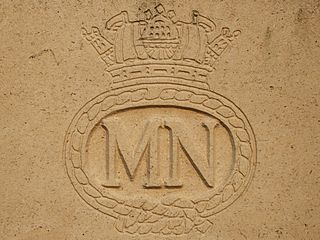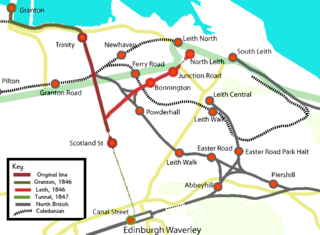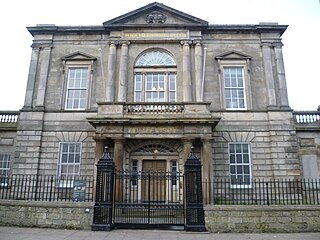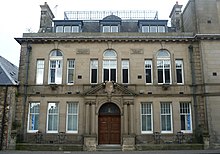
The Firth of Clyde is the mouth of the River Clyde. It is located on the west coast of Scotland and constitutes the deepest coastal waters in the British Isles. The firth is sheltered from the Atlantic Ocean by the Kintyre peninsula, which encloses the outer firth in Argyll and Ayrshire. The Kilbrannan Sound is a large arm of the Firth of Clyde, separating the Kintyre Peninsula from the Isle of Arran. Within the Firth of Clyde is another major island – the Isle of Bute. Given its strategic location at the entrance to the middle and upper Clyde, Bute played a vital naval military role during World War II.

Leith is a port area in the north of the city of Edinburgh, Scotland, founded at the mouth of the Water of Leith.

The Merchant Navy is the maritime register of the United Kingdom and comprises the seagoing commercial interests of UK-registered ships and their crews. Merchant Navy vessels fly the Red Ensign and are regulated by the Maritime and Coastguard Agency (MCA). King George V bestowed the title of "Merchant Navy" on the British merchant shipping fleets following their service in the First World War; a number of other nations have since adopted the title. Previously it had been known as the Mercantile Marine or Merchant Service, although the term "Merchant Navy" was already informally used from the 19th century.

The Union Canal, full name the Edinburgh and Glasgow Union Canal, is a canal in Scotland, running from Falkirk to Edinburgh, constructed to bring minerals, especially coal, to the capital. It was opened in 1822 and was initially successful, but the construction of railways, particularly the Edinburgh and Glasgow Railway, which opened in 1842, diminished its value as a transport medium. It fell into slow commercial decline and was closed to commercial traffic in 1933. It was officially closed in 1965. The canal is listed as three individual scheduled monuments by Historic Scotland according to the three former counties, Midlothian, West Lothian and Stirlingshire, through which it flows.

Alexander Hugh Bruce, 6th Lord Balfour of Burleigh, was a Scottish Unionist politician, banker and statesman, who took a leading part in the affairs of the Church of Scotland. He was Secretary for Scotland between 1895 and 1903.

A training ship is a ship used to train students as sailors. The term is mostly used to describe ships employed by navies to train future officers. Essentially there are two types: those used for training at sea and old hulks used to house classrooms.
Sighthill is a suburb in the west of Edinburgh, Scotland. The area is bordered by Broomhouse and Parkhead to the east, South Gyle to the north, the industrial suburb of Bankhead and the Calders neighbourhood to the west, and Wester Hailes to the south. It is sometimes included in the Wester Hailes area, while the Calders, Bankhead and Parkhead are sometimes considered parts of Sighthill. Administratively it has formed a core part of the City of Edinburgh Council's Sighthill/Gorgie ward since 2007.

Glasgow College of Nautical Studies was a further education college of nautical and maritime studies, and a provider of marine and offshore training courses. On 26 March 2009, it was announced that the college would merge with the Central College and Glasgow Metropolitan College. In 2010, the merger was completed the college was absorbed into the City of Glasgow College. Degree courses, in subjects including Naval Architecture and Marine Engineering, were offered in association with the University of Strathclyde.

William Denny and Brothers Limited, often referred to simply as Denny, was a Scottish shipbuilding company.
The Marine Engineering and Research Institute (MERI), formerly known as the Directorate of Marine Engineering Training (DMET), now known as Indian Maritime University - Kolkata Campus and Mumbai Port Campus, is India's national institute and one of the institutes for the training of Marine Engineers and Polyvalent Officers.
A central institution (CI) was a type of higher education institute in 20th and 21st century Scotland responsible for providing degree-level education but emphasising teaching rather than research. Some had a range of courses similar to polytechnics elsewhere in the United Kingdom while others were more specialised such as the art colleges and the conservatoire. Some subjects were not taught at central institutions, for example teacher training was only carried out by colleges of education, which later merged with universities.

Ferguson Marine Limited is a shipbuilding company whose yard, located in Port Glasgow on the Firth of Clyde in Scotland, was established in 1903. It is the last remaining shipbuilder on the lower Clyde and is currently the only builder of merchant ships on the river. For some years the company's mainstay has been Roll-on/roll-off ferries, primarily for Caledonian MacBrayne (CalMac), including a series of innovative hybrid diesel-electric/battery-powered vessels. Beset with difficulties since 2018 over their latest two CalMac ferries, Fergusons' largest ever vessel, the shipyard was nationalised in December 2019. It is now classified as an executive non-departmental public body of the Scottish Government.

The TS Golden Bear is the training ship of the California State University Maritime Academy (CSUMA), a campus of the California State University. The first training ship of the then–California Nautical School was known as the Training Ship California State, then as the T.S. Golden State. Since then, there have been three ships to bear the name T.S. Golden Bear.

Leith Walk is one of the longest streets in Edinburgh, Scotland, and is the main road connecting the centre of the city to Leith. Forming most of the A900 road, it slopes downwards from Picardy Place at the south-western end of the street to the 'Foot of the Walk' at the north-eastern end, where Great Junction Street, Duke Street, Constitution Street and the Kirkgate meet.

The Edinburgh, Leith and Newhaven Railway was a railway company formed in 1836 to connect the city of Edinburgh with the harbours on the Firth of Forth. When the line connected to Granton, the company name was changed to the Edinburgh, Leith and Granton Railway. It opened part of its route in 1846, but reaching the centre of Edinburgh involved the difficult construction of a long tunnel; this was opened in 1847. It was on a steep incline and was worked by rope haulage.
The City of Glasgow College is a further and higher education college in the city of Glasgow. It was founded in 2010 when the Central College, Glasgow Metropolitan College, and the Glasgow College of Nautical Studies merged. It is the largest college and technical institution in Scotland.

PMI Colleges, formerly known as Philippine Maritime Institute, is a private, non-sectarian, co-educational higher education, Maritime institution established on September 18, 1948 in Santa Cruz, Manila, Philippines where its main campus is located.

Trinity House, 99 Kirkgate, is a building in Leith, Edinburgh, Scotland, which was a guild hall, customs house, and centre for maritime administration and poor relief. In the Late Middle Ages and Early Modern Era it also served as an almshouse and hospital. Now in state care, it houses a maritime museum. It is a category A listed building.
HMS Dolphin was a screw sloop-of-war of the Royal Navy launched in 1882, used as school ship, and finally broken up in 1977.

Crawford's is a brand of biscuits.
















